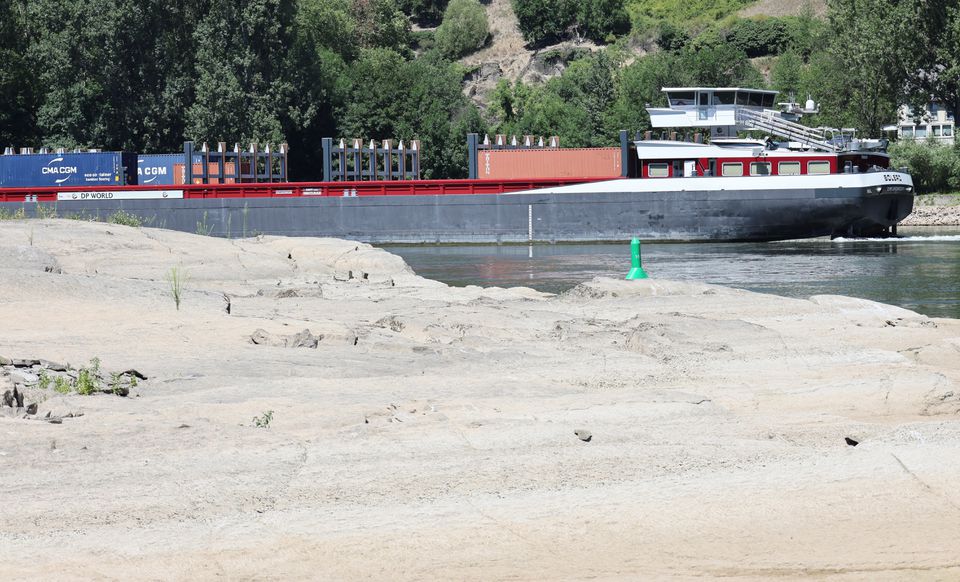Rhine River is one of the world’s busiest waterways and major transport artery for the Western European countries located on the banks thereof. However, due to the hot and dry summer, water level in Rhine River has fallen dramatically, therefore, transportation of goods and raw materials has become difficult. This is another blow to the economics during the time of booming energy prices. Climate changes may lead to critical situation also in the years to come.
More than 1,300 km long Rhine River begins in the Swiss Alps and flows through the territory of Switzerland, Liechtenstein, Austria, Germany, France and the Netherlands where it eventually empties into the North Sea. It connects industrial regions in Switzerland, Germany and the Netherlands with the Europe’s largest ports in Rotterdam and Antwerp. Every year, hundreds of millions of tons of various goods are shipped along the Rhine River.
This summer, water levels have fallen to the lowest point of the last decade in several locations of the river, therefore vessels are forced to transport significantly lighter cargoes to avoid running aground.
Water in the Rhine River is provided by the melting Alpine glaciers and precipitation, but, during the recent years, contribution of glaciers has decreased, because, due to the climate changes, more glaciers melt in the summer than are created in the winter. Last winter, amount of the precipitation registered in the Swiss Alps was lower than usual, therefore, the glaciers keep shrinking. Whereas, this summer, Western Europe has experienced several heat waves and sustained draught, therefore water Rhine River rapidly runs out of water.
The Federal Ministry for Digital and Transport (Germany) warned on Wednesday that, in the following days, water level in the Rhine River may reach critically low points. According to the estimates of the ministry, today, water level will drop to 40 at one of the narrowest points of the Rhine River by the city of Kaub in the Western Germany, and it will keep falling during the weekend. Although the water level will exceed here the critical level of record-low 27 centimetres registered in October 2018, larger vessels may find passing through this section of river approximately halfway between Koblenz and Mainz difficult.
Mr Kristian Lorenz, representative of the logistics company HGK, characterised the situation as very serious one, however, not as dramatic as in the fall of 2018. Nevertheless, operators are forced to adapt themselves to the situation. “Due to the low water levels, vessels delivering, for example, salt from Heilbronn to Cologne, are capable of transporting mere 600 tons instead of the usual 2,200. The lower is the water level, the smaller cargo can be transported by the vessels”, Mr Lorenz told the news agency “Associated Press”.
Such German industrial tycoons as steel producer “Thyssenkrupp” and the world’s largest chemical producer BASF depend on supplies of raw materials and energy resources, for example, coal and fuel along the Rhine River. This week, BASF announced that in case, if water level will drop to 35 centimetres by Kaub, part of barges will not be able to pass section of river.
Mr Jörg Uwe Beltz, expert with the Federal Institute of Hydrology, ascertained that, as soon as the water level will drop to below the 40-centimetre mark by Kaub, further carriage for majority of barges will no longer be economically profitable. “Due to the low water level, shipping is limited in the Rhine River, therefore transportation capacity of the inland merchant vessel fleet is accordingly lower. But this means that everyone depending on this waterway has lower supply capacities,” said Beltz.
Further down the stream of the Rhine River, by Duisburg, where the world’s biggest river port is located, water level in the middle of the week had dropped to 172 centimetres. If water level will fall to 150 centimetres at that point, transport of materials like coke and iron ore will no longer be economically profitable.
Shipment prices have soared through the roof this summer. For example, this week delivery of a ton of fuel to the Swiss city Basel cost 267 euro. For a comparison, at the beginning of June, delivery of a ton of fuel cost 25 euro, reports the news agency “Bloomberg”.
Companies can deliver products and raw materials also using railways and roads, but these ways of delivery are currently even more expensive.
Operators are getting ready for the situation that water level in the Rhine River will reach very low points more and more frequently in the following years, said representative of the logistics company HGK Kristian Lorenz. “All the new vessels are ordered and built to be able to pass also at places where water level is critically low. This is adequate reaction in the current situation”, stresses Mr Lorenz.
Lack of water in the major waterway of the Western Europe may seriously undermine the European Union’s (EU) plans to reduce carriage of goods by road and direct these flows to the largest rivers. The EU’s intent provides for that, by 2050, transport of goods along waterways should increase by 50% to be able to significantly reduce the amount of greenhouse gases generated by transport sector.
Author: Roland Peterson, logistics expert




